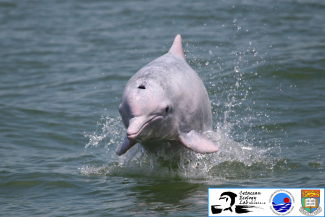Media
A new study by HKU researchers paints a bleak future for the Chinese white dolphins in the Pearl River Estuary
24 Feb 2017
Researchers at the University of Hong Kong conducted first of its type demographic study of the Chinese white dolphins inhabiting the Pearl River Estuary and say that the dolphins face a far greater threat than previously thought. The current demographic trajectory of the population and the ongoing loss of their critical habitats leave only a slim chance to prevent their stochastic extinction. For conservationists and management authorities, the time to act is now.
In the day-to-day practice of protecting threatened species and populations it is important to know the natural limits, the demographic and ecological threshold of their long-term survival. Because long-term survival of free-ranging populations depends on the carrying capacity of their habitat, the demographic and ecological threshold values represent the minimum population size that can be long-term viable and the minimum area of critical habitat that has to be maintained to secure a long-term survival of the minimum viable population.
These issues become particularly important for populations that face severe anthropogenic impacts, such as the Chinese white dolphins in waters of the Pearl River Estuary (PRE). The natural stochastic fluctuations of their environment are magnified by human impacts and escalate to levels that may impair their survival. It is not just the bare numbers, not just how many dolphins are in the area, but rather a dynamic network of interactions between the animals and their environment that determines the long-term survival of a species. Therefore accurate estimates of demographic and ecological thresholds of a population are critically important in designing effective conservation strategy.
For elusive animals such as dolphins and whales, such estimates are notoriously difficult to generate because of the inherent difficulties of collecting sufficiently robust demographic datasets. It takes many years of tedious data collection to build the minimum scientific evidence needed for such analyses; which is why very few attempts of such work have ever been done. A new study by researchers from the Swire Institute of Marine Science, the University of Hong Kong undertook this challenge for the Chinese white dolphins inhabiting waters of the Pearl River Estuary and the study has just been published (February 23, Thursday) in the journal Scientific Reports (link: http://rdcu.be/pyc8). It is first such study of coastal dolphins anywhere in the world.
The research was led by Dr. Leszek Karczmarski, Associate Professor at the School of Biological Sciences, and was co-authored by Dr. Shiang-Lin Huang, a former post-doctoral associate, and Mr. Stephen Chan, a Ph.D. student in Dr. Karczmarski's Lab.
The team estimated that, if human impacts were to be excluded and the population was stable, approximately 2,000 dolphins would represent a sufficiently viable population and, if given access to approximately 3,000 km2 of their undisturbed critical habitat, such population could persist across at least 40 generations (approximately 800 years).
The so-called "critical habitat" is the type of habitat that dolphins use for their daily needs; these are the areas where they find sufficient amount of food and shelter. In Hong Kong, it is primarily alongside the natural coastline of south and southwest Lantau Island. The amount and connectivity of this shallow-water habitat affects dolphins' survival; the less of the critical habitat there is the lower the likelihood of dolphin survival.
However, currently the PRE dolphin population is declining approximately 2.5% per year and is fast approaching its viability threshold. At the same time, all current marine protected areas (MPAs) in the PRE fail to secure the minimum habitat requirement to accommodate sufficiently viable population size that could withstand the ever-growing anthropogenic pressures.
Cumulatively, all current MPAs in both Hong Kong and Mainland waters cover just about 600 km2 and very little of it represent the dolphin critical habitat. Dr. Karczmarski referred to a recent study by Miss Carmen Or who last January completed her Ph.D. degree under his supervision, and pointed out that in Hong Kong less than 17% of the dolphins’ core areas and less than 7% of their core foraging grounds are under legal protection; and in Mainland waters this ratio is even smaller. Furthermore, he says, "most of the areas currently considered by Hong Kong authorities for the designation as MPAs include very little of the dolphins’ core areas and even less of their primary foraging grounds".
"To be effective - he says - conservation measures should not only increase the volume of the habitat under protection but, importantly, focus the conservation effort on the core areas and key habitats used by the dolphins for their daily needs. Preserving the ecological integrity of those areas should be among the primary conservation targets."
Unfortunately, he adds, "our findings indicate that the PRE dolphin population is deemed to become extinct unless effective conservation measures can rapidly reverse the current population trend".
Acknowledgement: The study was supported by the Research Grants Council of Hong Kong (RGC) and Ocean Park Conservation Foundation Hong Kong (OPCFHK).
For media enquiries, please contact Dr. Leszek Karczmarski, Associate Professor, The Swire Institute of Marine Science, School of Biological Sciences, Email: leszek@hku.hk.

